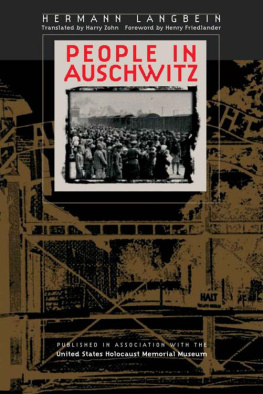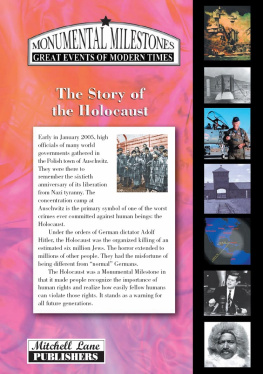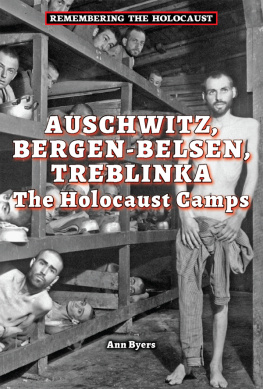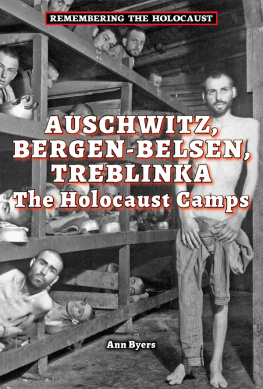Hermann Langbein - People in Auschwitz (Published in Association with the United States Holocaust Me)
Here you can read online Hermann Langbein - People in Auschwitz (Published in Association with the United States Holocaust Me) full text of the book (entire story) in english for free. Download pdf and epub, get meaning, cover and reviews about this ebook. year: 2005, publisher: The University of North Carolina Press, genre: Religion. Description of the work, (preface) as well as reviews are available. Best literature library LitArk.com created for fans of good reading and offers a wide selection of genres:
Romance novel
Science fiction
Adventure
Detective
Science
History
Home and family
Prose
Art
Politics
Computer
Non-fiction
Religion
Business
Children
Humor
Choose a favorite category and find really read worthwhile books. Enjoy immersion in the world of imagination, feel the emotions of the characters or learn something new for yourself, make an fascinating discovery.
- Book:People in Auschwitz (Published in Association with the United States Holocaust Me)
- Author:
- Publisher:The University of North Carolina Press
- Genre:
- Year:2005
- Rating:4 / 5
- Favourites:Add to favourites
- Your mark:
- 80
- 1
- 2
- 3
- 4
- 5
People in Auschwitz (Published in Association with the United States Holocaust Me): summary, description and annotation
We offer to read an annotation, description, summary or preface (depends on what the author of the book "People in Auschwitz (Published in Association with the United States Holocaust Me)" wrote himself). If you haven't found the necessary information about the book — write in the comments, we will try to find it.
Hermann Langbein: author's other books
Who wrote People in Auschwitz (Published in Association with the United States Holocaust Me)? Find out the surname, the name of the author of the book and a list of all author's works by series.
People in Auschwitz (Published in Association with the United States Holocaust Me) — read online for free the complete book (whole text) full work
Below is the text of the book, divided by pages. System saving the place of the last page read, allows you to conveniently read the book "People in Auschwitz (Published in Association with the United States Holocaust Me)" online for free, without having to search again every time where you left off. Put a bookmark, and you can go to the page where you finished reading at any time.
Font size:
Interval:
Bookmark:
PEOPLE IN AUSCHWITZ

Hermann Langbein. Photograph Alisa Douer; reprinted with permission.
People in Auschwitz
Hermann Langbein
Translated by Harry Zohn
Foreword by Henry Friedlander
The University of North Carolina Press
Chapel Hill & London
In association with the
United States Holocaust Memorial Museum
2004 The University of North Carolina Press
All rights reserved
Originally published in German as Menschen in Auschwitz ,
1995 Europa Verlag GmbH Wien Mnchen
Published in association with the United States Holocaust Memorial Museum. The assertions, arguments, and conclusions contained herein are those of the author or other contributors. They do not necessarily reflect the opinions of the United States Holocaust Memorial Museum.
The University of North Carolina Press gratefully acknowledges the support of the Federal Ministry for Education, Science, and Culture, Vienna, Austria; the Lucius N. Littauer Foundation; and the L. J. Skaggs and Mary C. Skaggs Foundation in the publication of this book.
Manufactured in the United States of America Set in Quadraat types by Tseng Information Systems, Inc. The paper in this book meets the guidelines for permanence and durability of the Committee on Production Guidelines for Book Longevity of the Council on Library Resources.
Library of Congress Cataloging-in-Publication Data
Langbein, Hermann, 1912
[Menschen in Auschwitz. English]
People in Auschwitz / Hermann Langbein; translated by Harry Zohn;
foreword by Henry Friedlander.
p. cm.
Published in association with the United States Holocaust Memorial Museum.
Includes bibliographical references and index.
ISBN 0-8078-2816-5 (cloth: alk. paper)
1. Auschwitz (Concentration camp) 2. World War, 19391945Prisoners and prisons,
German. 3. Holocaust, Jewish (19391945) I. Title.
D805.5.A96l3613 2004 940.531853858dc22 2003020485
08 07 06 05 04 5 4 3 2 1
I have felt obligated to write this book
for the sake of the countless people who
carried on a struggle against inhumanity
even in Auschwitz and lost their lives
especially in memory of
Ernstl Burger and Zbyszek Raynoch.
Contents
Foreword
Henry Friedlander
The name Auschwitz has come to symbolize the criminality of Nazi Germany. It not only was Germanys largest concentration camp but also housed its largest killing center. In the end, combining assembly-line mass murder and the exploitation of slave labor, Auschwitz was the premier Nazi installation of the Holocaust.
But Auschwitz did not launch the wholesale extermination of people deemed undesirable by the regime. In September 1939, at the beginning of World War II, before Auschwitz even existed as a place of incarceration and murder, the German concentration camp system was already firmly established. The individual camps of that systemDachau, Sachsenhausen, Buchenwald, Flossenbrg, Mauthausen, and Ravensbrckhad become infamous.
After the conquest of Poland, the Germans needed a new concentration camp to hold the large number of Poles who had been arrested as potential opponents to German rule. The search for the best site focused on Auschwitz, whose Polish name was Oswiecim. Its location at the juncture of the Vistula and Sola rivers made possible a large measure of isolation from the outside world. In addition, it provided essential railroad connections, being situated at the crossroads of Silesia, the General Government of Poland, the incorporated Wartheland, and the former states of Czechoslovakia and Austria. In early May 1940, Auschwitz was officially designated a German concentration camp, and SS Captain Rudolf H, who had served on the SS staff at Dachau and Sachsenhausen, was appointed commandant. About 1,200 Poles whose dwellings were on or near the proposed camp site were relocated, and soon thirty prisoners, all ordinary German criminals, arrived from Sachsenhausen, receiving Auschwitz prisoner numbers 1 through 30. In June, the first Polish political prisoners, including Polish Jews, were received at Auschwitz and were given prisoner numbers 31 through 758.
During 1940 and early 1941, the Auschwitz camp held mostly Polish prisoners; the remainder were German. This camp would eventually become the center of a system of camps, while its inmate population would be augmented with prisoners from all countries occupied by Germany. Known as the main camp, it would house the administration of the Auschwitz complex.
In January 1941, officials of IG Farben, the large German chemical concern, visited the Kattowitz region as the possible site for the production of a type of synthetic rubber known as buna. They took an interest in Auschwitz because the camp could provide cheap inmate labor. Eventually, inmate labor constructed the Buna Works at Monowitz, a short distance from the main camp. Other German industries followed, employing Auschwitz inmate labor in various subcamps. In March 1941, Reich Leader SS Heinrich Himmler ordered the construction of a large camp for 100,000 Soviet POWs at Birkenau, in close proximity to the main camp. Most of the Soviet prisoners were dead by the time Birkenau was reclassified as a concentration camp in March 1942.
With the German invasion of the Soviet Union in 1941, the Nazi regime moved to implement the so-called final solution, the murder of the European Jews and Gypsies. At first, SS killing squads shot their victims in mass executions, but soon the killings were moved to newly built extermination camps, where the victims were gassed with carbon monoxide.
Assembly-line mass murder in gas chambers started with the systematic execution of persons with disabilities under a program euphemistically called euthanasia. Starting in the winter of 193940, six killing centers on German soil, each with a gas chamber and a crematorium, put to death about 80,000 disabled patients in less than two years. Thereafter the killing of the disabled ran parallel to the murder of Jews and Gypsies. Since the overcrowded concentration camps did not yet have the means for rapidly killing large numbers of people, the facilities of the euthanasia program were utilized. Commissions of euthanasia and SS physicians selected inmates for shipment to the euthanasia centers. In July 1941, victims began to be selected in Auschwitz.
Sometime in the summer of 1941, Himmler informed H, the Auschwitz commandant, that he had chosen his camp as one of the sites where the final solution would be implemented. Although the SS in Auschwitz would eventually copy the euthanasia method of mass killingwith gas chambers, crematoria, and the stripping of gold teeth from corpsesit used hydrogen cyanide, known by the trade name Zyklon B, rather than carbon monoxide. As an experiment, the SS tried out Zyklon B, otherwise used as a pesticide in concentration camps, to kill Soviet POWs in August 1941.
In February 1942, the first transports of Jews arrived in Auschwitz; the victims were gassed in the Old Crematorium at the main camp. In March 1942, the killing operation was moved to Birkenau, utilizing two farm buildings for this purpose. During the period MarchJune 1943, the construction there of four large structures, each housing a gas chamber and a crematorium, was completed. Soon, massive gassings commenced, claiming altogether about 1.1 million victims.
In November 1943, the expansion of the killing operation, of industrial activities, and of the inmate population at Auschwitz led to a reorganization of the camp structure, resulting in three camps, each with its own commandant: the main camp (Auschwitz I), Birkenau (Auschwitz II), and Monowitz (Auschwitz III). Auschwitz I did, however, retain some overall control. The commandant of the main camp served as post senior, and various central offices, especially the Political Department and the post physicians administration, were still located in the main camp.
Next pageFont size:
Interval:
Bookmark:
Similar books «People in Auschwitz (Published in Association with the United States Holocaust Me)»
Look at similar books to People in Auschwitz (Published in Association with the United States Holocaust Me). We have selected literature similar in name and meaning in the hope of providing readers with more options to find new, interesting, not yet read works.
Discussion, reviews of the book People in Auschwitz (Published in Association with the United States Holocaust Me) and just readers' own opinions. Leave your comments, write what you think about the work, its meaning or the main characters. Specify what exactly you liked and what you didn't like, and why you think so.








